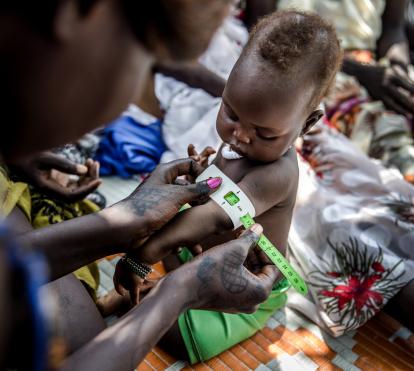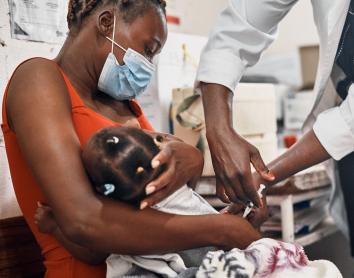
Global Aid Cuts Could Reverse Decades of Progress in Health and Development
18.11.25
5 minutes readThe abrupt decline in Official Development Assistance (ODA) could result in more than 22 million additional deaths by 2030, including 5.4 million children under five, according to a new study led by the Barcelona Institute for Global Health (ISGlobal), with support from The Rockefeller Foundation through its public charity RF Catalytic Capital. The findings highlight that the ongoing cuts to global aid not only threaten humanitarian and development programmes, but could also undo decades of progress in reducing preventable mortality across low- and middle-income countries (LMICs).
The study, “The Impact of Two Decades of Humanitarian and Development Assistance and the Projected Mortality Consequences of Current Defunding to 2030: Retrospective Evaluation and Forecasting Analysis”, was conducted by researchers from ISGlobal (Spain), an institution supported by the “la Caixa” Foundation, the Institute of Collective Health at the Federal University of Bahia (Brazil), the Manhiça Health Research Centre (CISM) and the National Institute of Health (INS) in Mozambique. The research, which is currently available in the preprint format, combines a retrospective analysis of ODA’s health impact from 2002 to 2021 with forecasting models that project mortality under current and future aid defunding scenarios up to 2030.
“These results reveal the enormous contribution of international aid to global health over the past two decades,” says Davide Rasella, Coordinator of the study and ICREA Research Professor at ISGlobal. “The abrupt contraction of ODA funding could have severe repercussions, leading to substantial increases in preventable adult and child deaths in the coming years. Beyond the immediate human toll, it could also critically undermine the achievement of the 2030 Sustainable Development Goals.”
A continuation of previous findings on USAID defunding
This work builds on a previous ISGlobal-led study, published earlier this year, which estimated that the dismantling of the U.S. Agency for International Development (USAID) could lead to over 14 million additional preventable deaths by 2030. Both analyses applied the same methodological framework, integrating longitudinal panel data with validated country-level microsimulation models—to quantify the health consequences of funding reductions. While the USAID study focused on a single donor, the new analysis encompasses all OECD contributors, providing a comprehensive assessment of global aid defunding on mortality.
ODA saved millions of lives, now millions are at risk
Using this approach, the authors found that ODA has had a measurable and sustained impact on health outcomes worldwide. Between 2002 and 2021, higher ODA funding levels were associated with a 23% reduction in all-cause mortality and a 39% decline in child mortality across 93 LMICs. Aid investments were particularly effective in reducing deaths from HIV/AIDS (70%), malaria (56%), and nutritional deficiencies (56%), while significant reductions were also observed in mortality from tuberculosis, diarrhoeal diseases, lower respiratory infections, and maternal and perinatal causes.
Beyond its direct health impacts, ODA has also played a crucial role in strengthening and sustaining health systems, supporting disease control and eradication efforts, and enhancing preparedness for outbreaks and epidemics.
However, the simulations show that the current wave of defunding—driven by deep cuts from the United States, the United Kingdom, France and Germany, among others—could reverse these gains. Under a severe defunding scenario, the study projects 22.6 million additional deaths by 2030, while even a mild scenario could result in 9.4 million preventable deaths. The scale of this projected toll is comparable to a global crisis. At the peak of the COVID-19 pandemic, an estimated 14.9 million excess deaths occurred worldwide, according to the World Health Organization. The mortality linked to current aid cuts could surpass even that.
An unprecedented contraction in aid
“ODA, which represents most international development and humanitarian funding, supports key sectors such as health, education, water and sanitation, and food security,” states Andrea Ferreira da Silva, Postdoctoral Researcher at the Institute of Collective Health (ISC) in Brazil.
For the first time in nearly 30 years, the United States, France, Germany, and the United Kingdom have all reduced their ODA contributions in 2024. If they proceed with announced cuts in 2025, it will be the first time in history that all four have cut ODA simultaneously for two consecutive years. The dismantling of USAID alone represents an estimated 83% reduction in its programmes, cutting overall U.S. aid funding by approximately half, while overall ODA funding is estimated to be reduced by 21% in 2025 in comparison with 2023.
“This is not just a budget issue,” says Claudia García-Vaz, ISGlobal Policy Coordinator. “It’s a matter of life and death for millions of people. The defunding of global aid is a moral catastrophe and a ballast on global prosperity.” “The abrupt ODA cuts are already severely impacting the most vulnerable,” adds Ariel Nhacolo, a Senior Demographer at CISM in Mozambique.
A wake-up call for the international community
“Development aid remains one of the most effective tools to save lives, strengthen health systems and reduce poverty”, stresses Rodrigo Volmir Anderle, ISC Postdoctoral Researcher. The authors call on donor countries and international organisations to urgently reconsider current funding decisions, step up to cover the gap, and reaffirm their commitments under the Sustainable Development Goals (SDGs). “The sudden withdrawal of aid threatens to dismantle systems that took decades to build,” Rasella concludes. “Reversing this trend is essential not only for global health, but for global stability.”



